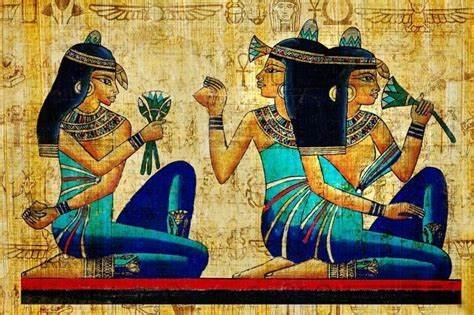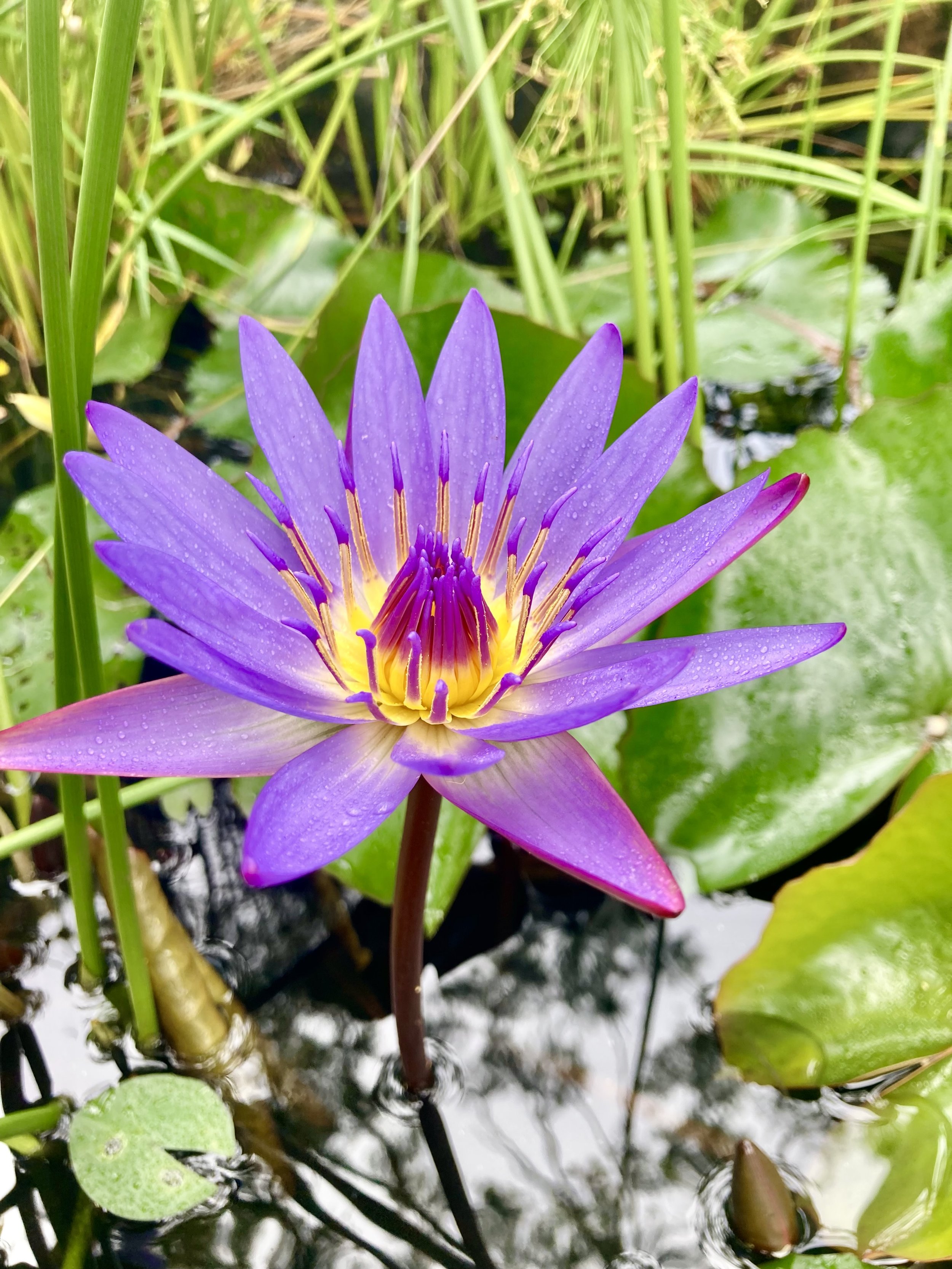The Sacred Blue Lily of the Nile~ Blue Lotus
“the lily which shines in the earth.”
~Egyptian Book of the Dead~
The world of plant medicine is so vast and mysterious. Plants are some of our oldest allies, the history of plant medicine is intimately tied to our own. For as long as humans have been in existence so has our relationship to plants. In many ways modern society has lost this relationship however when we look into our past, we gain a glimpse into this long and rich relationship.
There are certain plants whose uses far exceeded being simply used as medicine. Plants have long been used in the expansion of human consciousness and as gateways to connecting to higher realms of being.
Blue Lotus, Nymphaea caerulea is most certainly one of these plants. Also known as The Sacred Blue Lily of the Nile, Blue Lotus has been revered by many ancient cultures and civilizations from Ancient Egypt to the Ancient Greeks, Tibetans, and more. Reigning from the lily family, Blue Lotus is a water lily growing wild in ponds and other bodies of water emerging from the primordial waters to bloom once a year for only three days. Blue Lotus opens every morning as the sun rises and closes at sunset after which it pulled under the surface of the water, existing there until it is reborn and rises again. The flowers of Blue Lotus are highly valued for their exquisite beauty, intoxicating aroma, and their euphoria inducing effects.
In Ancient Egypt
Perhaps the most sacred and revered plant in Ancient Egypt, Blue Lotus was used extensively in medicine, magic, ritual, and celebration. The flower is depicted everywhere in Ancient Egyptian Temples and writings. It’s hard to find pieces of this ancient civilization without it. The Ancient Egyptians had a deep understanding of the nature of life and creation. The entirety of their culture was steeped in reverence for the natural world from the animals to the plants and everything in between.
Egyptian Women and Blue Lotus
The Ancient Egyptians had many traditional uses and applications of Blue Lotus. The flowers of Blue Lotus were steeped in wine which was then shared during religious ceremonies, rituals, and celebrations. Blue Lotus is said to connect one to the Divine, inducing higher states of being and consciousness. It is for this reason it was widely used in religious rites and ceremonies. Blue Lotus is said to induce a state of euphoria, promote relaxation, & improve circulation, making it a potent aphrodisiac. The Ancient Egyptians were known for being a sexual people, regularly taking part in rituals and celebrations around sexuality. There are countless depictions of these “famous celebrations,” and Blue Lotus is a central symbol within them. In the Old and New Kingdoms there was a particular connection between Blue Lotus and female sexuality and women were frequently depicted with the flower as well as the fruit of mandrake, these two plants were also often included in love poems.
The lily is often associated with symbols of creation, rebirth, death, & the sun. Part of its symbolism comes from the way it grows~ like other water lilies Blue Lotus emerges from the murky waters once a year to bloom for only three days, it also rises with the sun and retreats back into the primordial waters as the sun sets. In Egyptian mythology, creation came from the primordial waters of Nun. They believed that in the beginning there was water and from that, creation was birthed. I find a powerful connection here, it is no wonder to me that Blue Lotus is the most sacred plant medicine to the Ancient Egyptians as it is tied to the creation of life itself. In fact, this connection goes even deeper when we look at the god Nefertem who is strongly associated with the blue water lily, he is said to have emerged from the primordial waters in the lily itself.
The sacred lily was also strongly associated with the goddess Hathor, the goddess of love, healing, and also intoxication. Hathor was said to offer a bridge to other worlds through intoxication as well as ecstatic experiences. She was like the lily, also strongly associated with symbols of death & rebirth. In ancient times there was a particular emphasis on the concept of “divine inebriation,” or drunkenness. From Ancient Greece to Ancient Egypt there is strong archaeological evidence revealing the important role that entheogenic plants and brews played in such cultures. Said substances were used to commune with the “divine,” and all throughout time and around the world we can make the connection that such substances played an important role in the evolution of consciousness.
Blue Lotus is also mentioned in “The Egyptian Book of the Dead,” as “the lily which shines in the earth.” There are further references to the water lily in these texts as being a vehicle to ascension and rebirth. It was often integrated into ceremonies after death as a guide helping the soul reach the heavens. In other myths, such as a variation of the story of Horus the flower is presented as a symbol of the “all seeing eye,” when Seth rips out the eye of Horus he buries it in the sand where it is than transformed into a lily.
Egyptian God Nefertem, who is strongly associated with Blue Lotus
Medicinal Uses & Pharmacology
Blue Lotus in smaller doses is a nervine and relaxant helping to relax and calm the nervous system. It is also an amazing antispasmodic herb; helping to relax tight and tense muscles, allowing energy and vitality to flow more fluidly throughout the body. The energetics of the flower are bitter and cooling in nature.
The psychoactive properties of the plant are primarily attributed to two alkaloids: apomorphine and nuciferine. Apomorphine is a nonselective dopamine receptor agonist and activates serotonin receptors and α-adrenergic receptors. This alkaloid has been used as a sedative and hypnotic used to treat a wide range of conditions such as insomnia and anxiety since the late 1800’s. It stimulates dopamine receptors and improves motor function which is why it has been used in the treatment of Parkinson’s disease. Nuciferine is associated with dopamine receptor blockade and has shown therapeutic potential as an “anti-psychotic drug.” It also shown potential in the treatment of vascular diseases where abnormal vasoconstriction is present, alluding to its potential as a vasodilator which relaxes blood vessels and arteries.
Due to many of the actions above, Blue Lotus has long been traditionally used as an aphrodisiac. Blue Lotus relaxes the mind and body allowing vitality to flow more fluidly all while inducing a mild euphoric state. It is a wonderful herb to work with to deepen intimacy and connection.
Personal Experience
I became fascinated with Ancient Egypt at a very young age and at the age of 19 I traveled to there on my own. It was the adventure of a lifetime that quite literally shattered my reality in countless ways and opened up my perception and understanding of the world as I knew it. The Ancient Egyptians were on to something, something precious and integral to the nature of life and the potential of our existence as human beings, that’s all I knew.
Despite being an herbalist fascinated with Ancient Egypt, I did not fully meet this plant in my body and consciousness until fairly recently. My first interaction was in small amounts in tea before bed. In this dosage and preparation I found Blue Lotus to be relaxing, inducing a dream like state. I found its effects to be subtle helping me drift into more easeful sleep. My dreams the first night however were very active and much more vivid. I also noticed dream recollection increased the next morning.
There was a night that I explored this medicine with a lover. We took a spagyric tincture of the flowers which is a traditional alchemical preparation. It was this evening I experienced the more psychoactive properties of this plant, but it was so different than any other experience with a psychoactive I had ever had. It was gentle but very profound, as we made love that night I felt completely immersed in the beauty of this flower and the sacredness of sex, intimacy, & connection.
For me, Blue Lotus is also a plant of connection, helping us connect more deeply to whatever it is we are trying to connect with, be it a lover, friend, plant, animal, guide, and more. What a beautiful gift it is.
Sourcing and Sustainability
Despite its overwhelming presence in Ancient Egypt it is very difficult to find this flower still growing in this region today. Due to this and the unique way in which Blue Lotus grows it can be fairly difficult to find ethical and reliable sources of the plant.
Anima Mundi Herbals based out of Costa Rica is a wonderful and ethical source of wildcrafted Blue Lotus, you can find a link to purchase this plant here Blue Lotus, Anima Mundi Herbals.
To inquire about the Spagyric extract mentioned above visit Blue Lotus Spagyric Tincture
Thank you for reading my musings on this beautiful plant.





